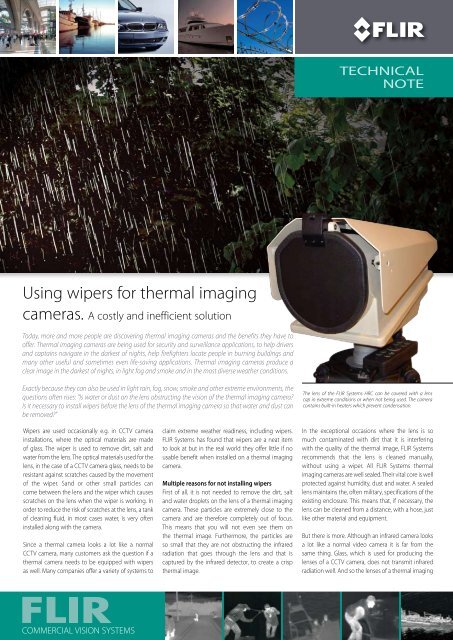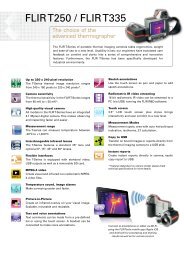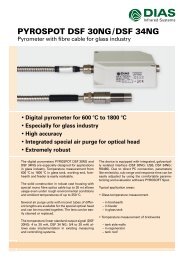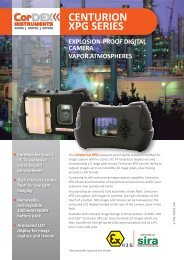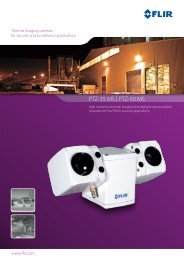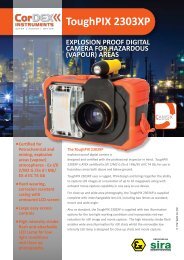Using wipers for thermal imaging
Using wipers for thermal imaging
Using wipers for thermal imaging
Create successful ePaper yourself
Turn your PDF publications into a flip-book with our unique Google optimized e-Paper software.
technical<br />
note<br />
<strong>Using</strong> <strong>wipers</strong> <strong>for</strong> <strong>thermal</strong> <strong>imaging</strong><br />
cameras. A costly and inefficient solution<br />
Today, more and more people are discovering <strong>thermal</strong> <strong>imaging</strong> cameras and the benefits they have to<br />
offer. Thermal <strong>imaging</strong> cameras are being used <strong>for</strong> security and surveillance applications, to help drivers<br />
and captains navigate in the darkest of nights, help firefighters locate people in burning buildings and<br />
many other useful and sometimes even life-saving applications. Thermal <strong>imaging</strong> cameras produce a<br />
clear image in the darkest of nights, in light fog and smoke and in the most diverse weather conditions.<br />
Exactly because they can also be used in light rain, fog, snow, smoke and other extreme environments, the<br />
questions often rises: “Is water or dust on the lens obstructing the vision of the <strong>thermal</strong> <strong>imaging</strong> camera?<br />
Is it necessary to install <strong>wipers</strong> be<strong>for</strong>e the lens of the <strong>thermal</strong> <strong>imaging</strong> camera so that water and dust can<br />
be removed?”<br />
The lens of the FLIR Systems HRC can be covered with a lens<br />
cap in extreme conditions or when not being used. The camera<br />
contains built-in heaters which prevent condensation.<br />
Wipers are used occasionally e.g. in CCTV camera<br />
installations, where the optical materials are made<br />
of glass. The wiper is used to remove dirt, salt and<br />
water from the lens. The optical materials used <strong>for</strong> the<br />
lens, in the case of a CCTV camera glass, needs to be<br />
resistant against scratches caused by the movement<br />
of the wiper. Sand or other small particles can<br />
come between the lens and the wiper which causes<br />
scratches on the lens when the wiper is working. In<br />
order to reduce the risk of scratches at the lens, a tank<br />
of cleaning fluid, in most cases water, is very often<br />
installed along with the camera.<br />
Since a <strong>thermal</strong> camera looks a lot like a normal<br />
CCTV camera, many customers ask the question if a<br />
<strong>thermal</strong> camera needs to be equipped with <strong>wipers</strong><br />
as well. Many companies offer a variety of systems to<br />
claim extreme weather readiness, including <strong>wipers</strong>.<br />
FLIR Systems has found that <strong>wipers</strong> are a neat item<br />
to look at but in the real world they offer little if no<br />
usable benefit when installed on a <strong>thermal</strong> <strong>imaging</strong><br />
camera.<br />
Multiple reasons <strong>for</strong> not installing <strong>wipers</strong><br />
First of all, it is not needed to remove the dirt, salt<br />
and water droplets on the lens of a <strong>thermal</strong> <strong>imaging</strong><br />
camera. These particles are extremely close to the<br />
camera and are there<strong>for</strong>e completely out of focus.<br />
This means that you will not even see them on<br />
the <strong>thermal</strong> image. Furthermore, the particles are<br />
so small that they are not obstructing the infrared<br />
radiation that goes through the lens and that is<br />
captured by the infrared detector, to create a crisp<br />
<strong>thermal</strong> image.<br />
In the exceptional occasions where the lens is so<br />
much contaminated with dirt that it is interfering<br />
with the quality of the <strong>thermal</strong> image, FLIR Systems<br />
recommends that the lens is cleaned manually,<br />
without using a wiper. All FLIR Systems <strong>thermal</strong><br />
<strong>imaging</strong> cameras are well sealed. Their vital core is well<br />
protected against humidity, dust and water. A sealed<br />
lens maintains the, often military, specifications of the<br />
existing enclosure. This means that, if necessary, the<br />
lens can be cleaned from a distance, with a hose, just<br />
like other material and equipment.<br />
But there is more. Although an infrared camera looks<br />
a lot like a normal video camera it is far from the<br />
same thing. Glass, which is used <strong>for</strong> producing the<br />
lenses of a CCTV camera, does not transmit infrared<br />
radiation well. And so the lenses of a <strong>thermal</strong> <strong>imaging</strong><br />
COMMERCIAL VISION SYSTEMS
technical<br />
n o t e<br />
camera are made of germanium. This metal is a good<br />
transmitter of infrared radiation. It is however a very<br />
expensive metal so the lens needs to be protected as<br />
much as possible against scratches. If the germanium<br />
lens becomes scratched and pitched, e.g. by the<br />
small particles between a wiper and the lens, there<br />
is a steady decline in the <strong>thermal</strong> image quality. In<br />
situations where the smallest of details need to be<br />
detected, this is unacceptable.<br />
Most FLIR Systems infrared cameras have hard carbon<br />
coating. Although this coating is putting a protective<br />
layer over the lens and protecting it against scratches<br />
and pits in practically all weather conditions, it can be<br />
scratched and damaged by the use of a wiper.<br />
Another reason <strong>for</strong> installing <strong>wipers</strong> might be that the<br />
cameras are often per<strong>for</strong>ming in humid conditions<br />
and that condensation can occur on the lens. FLIR<br />
Systems <strong>thermal</strong> <strong>imaging</strong> cameras that need to<br />
per<strong>for</strong>m in these conditions are practically always<br />
equipped with built-in heaters that are preventing<br />
condensation on the lens. So again, there is no need<br />
to install <strong>wipers</strong>.<br />
Wipers: increasing cost and downtime<br />
When using a <strong>thermal</strong> <strong>imaging</strong> camera, installing<br />
<strong>wipers</strong> is definitely not the best option. Not only<br />
because they are likely to damage the expensive<br />
germanium lens of the camera, but installing <strong>wipers</strong><br />
is also a costly item in terms of initial system design<br />
and maintenance.<br />
Many of FLIR Systems’ Thermal <strong>imaging</strong> cameras<br />
use the front lens element as the seal against the<br />
environment and not an extra, flat IR window. This<br />
means that a potential wiper must follow the lens<br />
curvature to clean it properly.<br />
Customers that absolutely want to install a wiper,<br />
do not only have to face the price of the initial<br />
installation. Definitely in security and surveillance<br />
applications, <strong>thermal</strong> <strong>imaging</strong> cameras are often<br />
installed in a high position so that they can overlook<br />
an entire area. In a fixed pole or building mount<br />
scenario this requires man power to climb the pole<br />
and either replace the wiper at the top of the pole<br />
or un-mount the entire camera assembly and bring<br />
it to the ground <strong>for</strong> repair. In both cases this means<br />
an additional maintenance schedule. Not only will<br />
this increase the exploitation cost, but even more<br />
important, the camera will be out of use <strong>for</strong> a period<br />
of time which is often unacceptable.<br />
A wiper system <strong>for</strong> a <strong>thermal</strong> <strong>imaging</strong> camera must<br />
also include a water spray (or similar) in order to try<br />
avoiding lens damages. This is rather tricky with a slip<br />
ring based, continuous rotating Pan/Tilt Head (PTH).<br />
The cleaning fluid needs a reservoir installed on top<br />
of the Pan/Tilt (along with the cameras) and requires<br />
additional, regularly refill service.<br />
Experience has learned that if <strong>wipers</strong> and a water<br />
spray installation are installed there is always the risk<br />
of operators playing with it. This leads to additional<br />
refill services and maintenance which is again<br />
increasing the operational cost of the <strong>thermal</strong><br />
<strong>imaging</strong> system. And if the lens is really dirty, spraying<br />
water on it and cleaning it from a distance with a<br />
wiper, will create a layer of mud which will obstruct<br />
the <strong>imaging</strong> capabilities of the camera.<br />
Better options to protect the lens of a <strong>thermal</strong><br />
<strong>imaging</strong> camera in extreme conditions.<br />
All the above arguments quickly lead to the conclusion<br />
that installing <strong>wipers</strong> on a <strong>thermal</strong> <strong>imaging</strong> camera<br />
is not a good, and definitely not a cost effective,<br />
solution.<br />
It has to be admitted however that there are extreme<br />
conditions in which even a <strong>thermal</strong> <strong>imaging</strong> camera<br />
can not produce a clear image and where its<br />
germanium lens needs to be protected against the<br />
environment in order to protect it against damage.<br />
FLIR Systems has installed many <strong>thermal</strong> <strong>imaging</strong><br />
cameras in extreme climate conditions. Numerous<br />
FLIR Systems cameras are being used today in the<br />
dessert, in arctic climates, along coastal borders, ...<br />
So how are the lenses protected against scratches<br />
in sand storms and other extreme conditions? FLIR<br />
Thermal imagers that are installed in these conditions<br />
are equipped with a so called “parking position”.<br />
This means that if they are not being used, <strong>for</strong><br />
whatever kind of reason, they can be remotely turned<br />
and positioned into a pose that they are protected<br />
against the environment. Another possibility is that a<br />
lens cap can be remotely positioned be<strong>for</strong>e the lens<br />
to protect it.<br />
In both cases, the expensive germanium lens is<br />
well protected against scratched and other possible<br />
damage. There is no risk at all, that by using a wiper,<br />
which is probably not effective at all, the lens is<br />
getting damaged.<br />
And FLIR Systems <strong>thermal</strong> <strong>imaging</strong> cameras that do<br />
have a dirty lens can be quickly, from a distance,<br />
cleaned with a hose, a fast and cost effective solution,<br />
so that they are again producing the crisp, clear,<br />
detailed <strong>thermal</strong> images <strong>for</strong> which FLIR Systems is<br />
renowned in the market.<br />
Both the<br />
FLIR Systems<br />
PTZ-35x140 MS and<br />
the Voyager have<br />
a parking position.<br />
In this position, the<br />
expensive germanium<br />
lens is protected<br />
against scratches.<br />
The protective lens cap of the HRC can remotely be positioned<br />
be<strong>for</strong>e the lens to protect it.<br />
For more in<strong>for</strong>mation about <strong>thermal</strong> <strong>imaging</strong><br />
cameras or about this application,<br />
please contact:<br />
FLIR Commercial Vision Systems B.V.<br />
Charles Petitweg 21<br />
4847 NW Teteringen - Breda - Netherlands<br />
Phone : +31 (0) 765 79 41 94<br />
Fax : +31 (0) 765 79 41 99<br />
e-mail : flir@flir.com<br />
www.flir.com<br />
TN_0308_0004_EN


